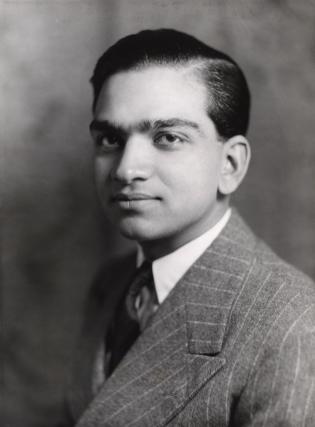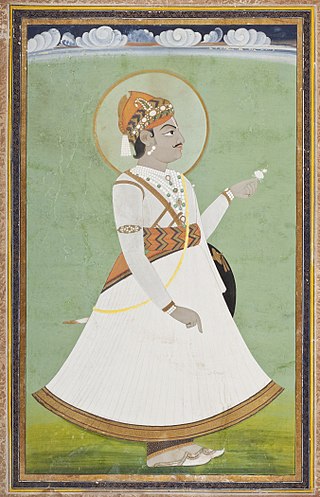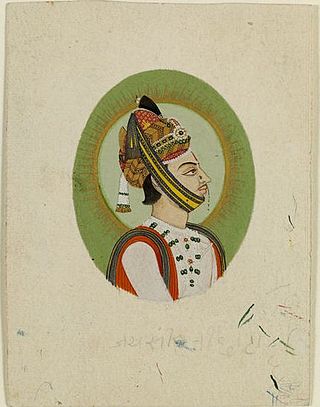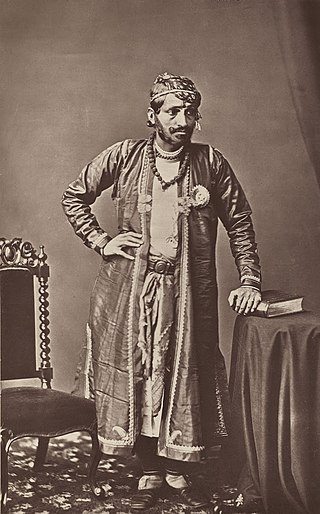
Gayatri Devi was the third Maharani consort of Jaipur from 1940 to 1949 through her marriage to Maharaja Sawai Man Singh II. Following her husband's signature for the Jaipur State to become part of the Union of India and her step-son's assumption of the title in 1970, she was known as Maharani Gayatri Devi, Rajmata of Jaipur.

Sawai Jai Singh II popularly known as Sawai Raja Jai Singh was the 29th Kachwaha ruler of the Kingdom of Amber, who later founded the fortified city of Jaipur and made it his capital.He became the ruler of Amber at the age of 11 after the death of his father,Mirza Raja Bishan Singh on 31 December 1699.

Chhatri are semi-open, elevated, dome-shaped pavilions used as an element in Indo-Islamic architecture and Indian architecture. They are most commonly square, octagonal, and round. Originating as a canopy above tombs, they largely serve as decorative elements as opposed to functional elements. The earliest examples of chhatri being used in the Indian Subcontinent were found in the Shrine of Ibrahim in Bhadreswar, constructed between 1159 and 1175 AD.

Rajput painting, painting of the regional Hindu courts during the Mughal era, was roughly from the end of the 16th century to the middle of the 19th century. Traditionally, Rajput painting is further divided into Rajasthan and Pahari painting which flourished in two different areas "far apart from each other in terms of distance but all under the rule of Rajput chiefs, and bound together by a common culture".

The Kachhwaha, or Kachawa is a Rajput clan found primarily in India.

Major General Maharaja Sawai Man Singh II GCSI GCIE was an Indian prince, government official, diplomat and sportsman.

Jaipur, the capital of Rajasthan state in India, was founded in 1727 by Maharaj Sawai Jai Singh II, who ruled Jaipur State from 1699–1744. He consulted several books on architecture and architects before making the layout of Jaipur.

Brigadier Maharaja Sawai Bhawani Singh MVC was an officer in the Indian Army and an entrepreneur.

Sawai Madho Singh I was ruler of the state of Jaipur in the present-day Indian state of Rajasthan. He was the younger son of Maharaja Sawai Jai Singh II and became ruler of Jaipur after his brother Sawai Ishwari Singh's death.

Sawai Pratap Singh was the Kachwaha ruler of the Kingdom of Jaipur. He was brought on the throne by his mother Maji Chundawatji after the suspicious death of his elder brother Sawai Prithvi Singh II in 1778.He is known for constructing the magnificent Hawa Mahal in Jaipur in the year 1799.

The Kingdom of Amber, also known as Kingdom of Dhoondar and Jaipur State, was located in the Dhundhar region of Rajputana and was ruled by the Kachhwaha clan. It was established by Dulha Rai, possibly the last ruler of the Kachchhapaghata dynasty of Gwalior who migrated to Dausa and started his kingdom there with the support of Chahamanas of Shakambhari in the 11th century. Mostly through 12th to 15th century, the kingdom faced stagnation, sources are scarce. Its ruler, Chandrasen became a Sisodia vassal and fought in the Battle of Khanwa under Prithviraj Kachhwaha.

Ram Gopal Vijayvargiya (1905–2003) was an Indian painter. He was also a poet and a writer.

Kingdom of Marwar, also known as the Jodhpur State under the British, was a kingdom in the Marwar region from 1243 to 1818 and a princely state under British rule from 1818 to 1947. It was established in Pali by Rao Siha, possibly a migrant Gahadavala noble, in 1243. His successors continued to struggle against regional powers for domination and 9 out of 15 rulers till 1438 died in combat. In 1395, its capital was changed to Mandore by Rao Chunda of Mandore and to Jodhpur in 1459 by Rao Jodha.

The City Palace, Jaipur is a royal residence and former administrative headquarters of the rulers of the Jaipur State in Jaipur, Rajasthan. Construction started soon after the establishment of the city of Jaipur under the reign of Maharaja Sawai Jai Singh II, who moved his court to Jaipur from Amber, in 1727. Jaipur remained the capital of the kingdom until 1949—when it became the capital of the present-day Indian state of Rajasthan—with the City Palace functioning as the ceremonial and administrative seat of the Maharaja of Jaipur. The construction of the Palace was completed in 1732 and it was also the location of religious and cultural events, as well as a patron of arts, commerce, and industry. It was constructed according to the rules of vastushastra, combining elements of Mughal and Rajput architectural styles. It now houses the Maharaja Sawai Man Singh II Museum, and continues to be the home of the Jaipur royal family. The royal family has around 500 personal servants. The palace complex has several buildings, various courtyards, galleries, restaurants, and offices of the Museum Trust.The MSMS II Museum Trust is headed by chairperson Rajamata Padmini Devi of Jaipur. Princess Diya Kumari runs the Museum Trust, as its secretary and trustee. She also manages The Palace School and Maharaja Sawai Bhawani Singh School in Jaipur. She founded and runs the Princess Diya Kumari Foundation to empower underprivileged and underemployed women of Rajasthan. She is also an entrepreneur. In 2013, she was elected as Member of the Legislative Assembly of Rajasthan from the constituency of Sawai Madhopur.

The Albert Hall Museum in Jaipur is the oldest museum of the state and functions as the state museum of Rajasthan, India. The building is situated in Ram Niwas garden outside the city wall opposite New gate and is a fine example of Indo-Saracenic architecture. It is also called the Government Central Museum. It was considered one of the best 19th century museums for the variety of its collections. It was renovated in 2008 and reopened as one of the most advanced museums in India.

Sawai Ishwari Singh was the ruler of Amber Kingdom later Kingdom of Jaipur. He was the second son of his father Maharaja Sawai Jai Singh II.

Sawai Jai Singh III, was the Maharaja of Jaipur. He was the father of his successor and only son Maharaja Ram Singh II

Sawai Ram Singh II was the Maharaja of Jaipur from 1835 until 1880, succeeding after the death of Jai Singh III. He became the ruler of Jaipur at the age of 16 months after his father's death. During his reign, he implemented various reforms, influenced by Western ideals and British preferences. He established new departments, reorganized the police force, and constructed roads to promote economic progress. Additionally, he aimed to transform Jaipur into a modern city, introducing schools, colleges, gas lights, and piped water supply. Ram Singh also focused on women's education, building schools and hospitals for their empowerment. Ram Singh was also an avid photographer. His reign marked a period of significant transformation and progress in Jaipur.
Prakash Chand Surana was an Indian jeweler, business person, philanthropist and a music connoisseur, known for his efforts to promote Hindustani music. He was the co-founder of Shruti Mandal, a music community in Jaipur and served as its president, under the aegis of which he reportedly attempted to revive Jaipur gharana tradition. Founded in 1964, the forum has hosted, over the years, such musicians as Kumar Gandharv, Ravi Shankar, Zakir Hussain, Bhimsen Joshi and Hariprasad Chaurasia. Born in 1939 in Jaipur in the Indian state of Rajasthan in a Marwari family, he inherited the family jewelry business and contributed to reviving the Kundan meenakari tradition of jewelry making. Surana, who was married to Shobha Devi and had four children- Chandra, Manju, Pracheer & Priti, died on 5 February 2015, succumbing to a cardiac arrest. The Government of India awarded him the fourth highest civilian honour of the Padma Shri, posthumously in 2016, for his contributions to arts. He was also a recipient of Sawai Bhawani Singh Award for excellence in business and industry and Dagar Gharana Award of the Maharana of Mewar Foundation.
The Battle of Rajamahal was a military engagement fought in 1747 in Jaipur, India. The battle was fought between the forces of Sawai Maharaja Ishwari Singh and Maharana Jagat Singh, who wanted to make his nephew Madho Singh the Maharaja of Jaipur or secure a Jagir for him, he built an alliance with the Maratha's under Khanderao Holkar and the Hada clan of Bundi and Kota. The battle resulted in a decisive victory for Ishwari Singh's forces.

















